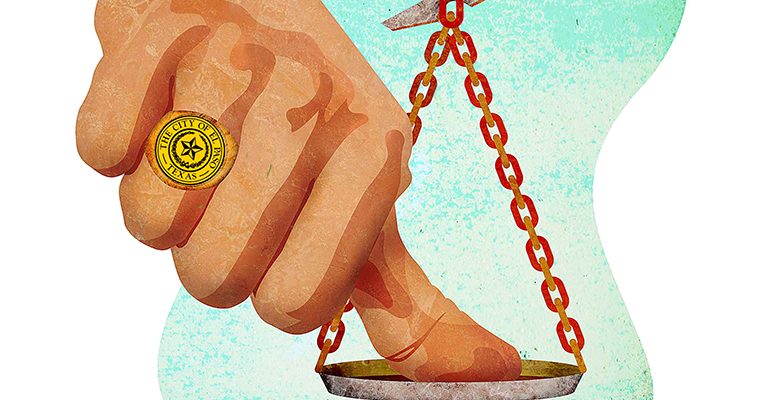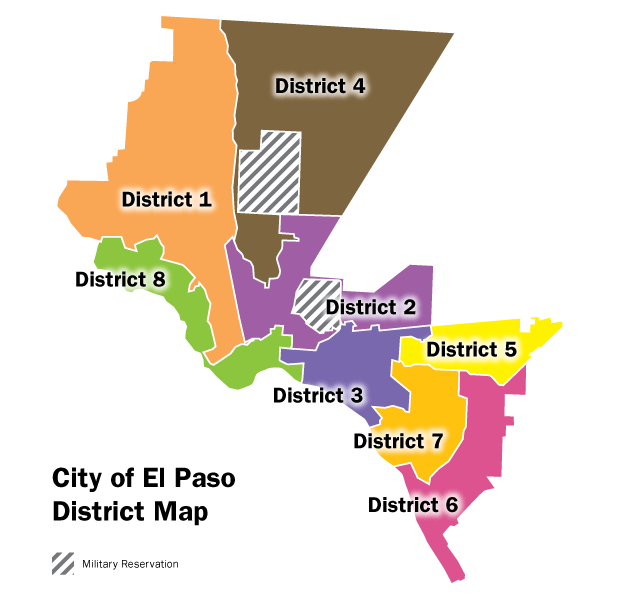This article originally appeared on 03 August 2015.
If you only read the local newspapers, and maybe watch the City Council meetings on the internet, you might not know how poor El Paso is. According to this article from CBS News, El Paso is the eighth poorest city in the U.S. If you want to compare paychecks, Forbes pegs us at 97th out of the hundred biggest Metropolitan Statistical Areas in the country.
You don’t see those rankings scrolling across the electronic signboards on the city’s buses.
How can the City, and the media, ignore this economic reality?
Have you examined a map of the City’s legislative districts?
Except for a few pockets of opulent abundance, poverty is widely distributed in El Paso. But the poorest zip codes are south of the freeway.
See how the poorer neighborhoods have had their political power diluted by slicing them up and dividing them among wealthier districts? Districts 8, 3, 7, and 6 all get a chunk of the neighborhoods south of the freeway, while the bulk of those districts are composed of wealthier areas north of it.
If City Government, and their puppet masters, wanted to be fair about local governance, they’d have given the poor their own representative on City Council. There’d be a district for people south of the freeway. Instead City Council gerrymandered the districts to dilute the influence of our gente humilde.
Maybe you think that’s a good thing. Like maybe we don’t need to give those largely less educated a seat at the table. But despite your fantasies and aspirations, the interests of the poor largely coincide with the middle class majority of El Pasoans more than the fat cats.
Look at District 8. If the interests of the wealthy people in District 8, who live in the Willows and the Upper Valley, conflict with the interests of the people in the Segundo Barrio, how do you think the representative for District 8 will vote? The gente in Segundo don’t vote much, whereas the wealthy folks in the Upper Valley not only vote, they contribute to campaigns.
Politicians complain about our low voter participation rates in El Paso, but how can you expect people to vote if they’re not represented?
The system is so ingrained that the humble people along the border are grateful for whatever crumbs the city gives them. They need a champion to lift them up, instead of politicians who sell them out.



And who drew those lines and when? Gee, could it be the Powers That Rule??
This may have been before I started following you, Rich. It is spot on, and now that I see it spelled out, I guess it is pretty obvious. I first came to El Paso in late 1967, transferred to Ft. Bliss. Not much of this city as we know it today, existed east of about Yarbrough, or west of Mesa/Doniphan. Northeast ended just past McCombs and Dyer. The time to set up proper districts was likely even before that time, and now, look at us. Not only poor, but dominated in our direction by the few rich, who do control everything. We lived in the Valley for just over 20 years (Pasodale, then near Socorro), and experienced the lowest of the low during that time. Not much has changed for those neighborhoods, and this is why.
Anyone know how the districts were formed? Should have a new map with populations accounting for districts. Might even get rid of a couple of reps off city council.
According to the City Charter, El Paso will have eight representative until the population reaches one million.
The districts are to be redrawn after every ten year census, which means like 2021 for us. The boundaries are redrawn to ensure that an equal number of people live in each district. The districts are redrawn by people appointed by City Council, one person per Representative. I don’t recall if the mayor also gets a appointment.
The redistricting of the city occurred try to do the opposite of what occurred. Those on the committee thought that the poor neighborhoods would control the rich neighborhoods. You may recall that JJ Armes was redistricting out. It was a deliberate effort to change the traditional above the freeway and below the freeway.. I sat in on some of the meetings at City Hall. This occurred after the 1990 census.